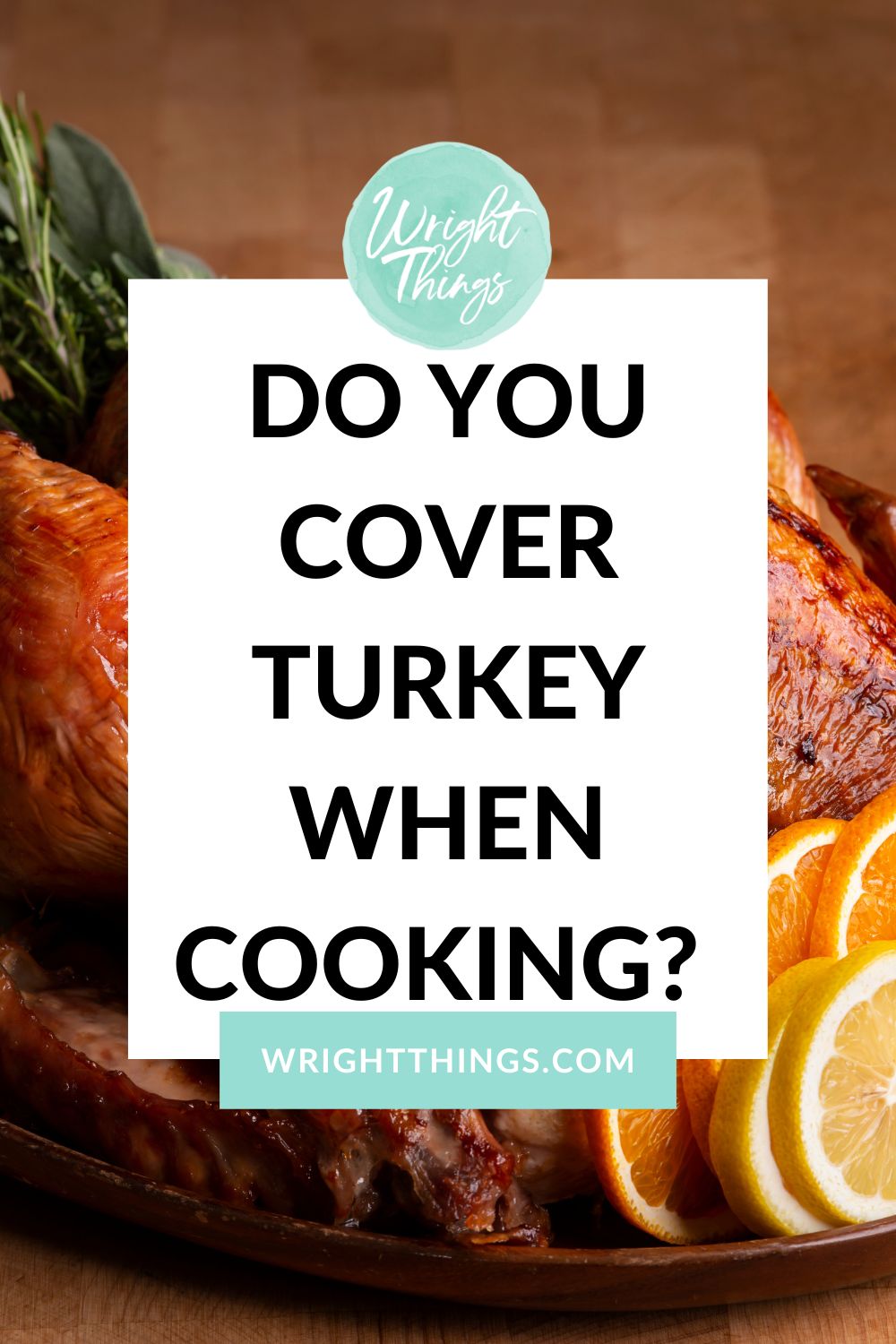It doesn’t matter if Thanksgiving is around the corner or if you’re just wanting to make a whole turkey for dinner one night. Cooking your turkey bird properly is essential in serving a moist and juicy dinner for your family. One of the biggest questions when in the kitchen with a turkey is, “should you cover a turkey when cooking it”.
The answer is not as simple as yes or no. Covering a turkey while it roasts can have both positive and negative effects on the final result, so you should be aware of all your options before deciding whether or not to cover your bird.
If this is your first time and you’re ready to learn more about roasting a turkey, then keep reading… and if this has your curiosity peaked, go ahead and see if you should cover chicken when baking! And if you’re a seasoned pro at cooking the best turkey dinners, we are sure there is still something for you to learn here.
Should You Cover a Turkey When Cooking?
When it comes to roasting a turkey, there is no hard and fast rule about whether or not you should cover your bird. Ultimately, the decision on whether or not to cover a turkey when cooking depends on what kind of result you are looking for in the end. Here are some of the pros and cons of covering your turkey while it is in the oven.
The Benefits of Covering Your Turkey
Covering your turkey with a piece of foil or using one of the other methods can help it cook faster and ensure even browning throughout the entire bird. It also helps trap moisture inside, ensuring that your turkey stays juicy and flavorful. If you want to make sure your holiday feast or delicious weeknight dinner is perfect from start to finish, then covering your turkey might be the way to go.
The Downside of Covering Your Turkey
On the other hand, covering your turkey also has its downside. For one thing, it can make it difficult for fat and juices to escape during cooking, which means that some parts of the bird may end up being greasy or oily.
Additionally, covering a turkey can prevent the skin from becoming crispy while cooking – crispy skin can be something that many people look forward to on Thanksgiving day or when they see a roasted turkey on the table for dinner. So keep that in mind if you’re considering covering your turkey.
Finally, covering a turkey can cause it to lose some of its flavor due to trapped steam. If you’re looking for maximum flavor in every bite, then you may want to consider leaving your turkey uncovered while it is in the oven.
There are other ways you can ensure even browning without having to cover your bird entirely – such as basting with butter or oil – so consider those options before deciding whether or not you should cover your turkey this holiday season!
Now that we know some pros and cons of covering your turkey while cooking, lets look at a few ways to do so (if that is what you wish to do).
Ways to cover a turkey when cooking
The most common way to cover a turkey is with aluminum foil. This helps trap moisture inside the bird, while also allowing some of the fat and juices to escape during cooking. It also helps keep your turkey from drying out too quickly. However, you should be careful not to wrap it too tightly as this can cause uneven cooking and result in a drier bird.
Another option is to place a lid or roasting pan over the turkey. This works in much the same way as foil, but it does not trap as much steam and moisture. The downside of this method is that you may end up with some uneven browning on the top of your turkey.
Additionally, you can also cover a turkey with an oven-safe baking sheet. This allows some of the fat and juices to escape during cooking, while at the same time trapping enough steam and moisture to keep your turkey moist and juicy. The downside is that it may take longer for your bird to cook this way, so make sure to plan accordingly.
Overall, these are just a few of the ways you can ensure your turkey is moist, juicy and delicious when you serve it to your family or friends. Experiment with different cooking styles to see which one works best for you.
No matter which method you choose, it is important to remember that the goal should be for your turkey to have even browning throughout and remain juicy and flavorful. If you follow these tips, then you can enjoy a perfect turkey dinner every time!
Tips to Roast A Turkey
Here are some things to remember when baking your turkey:
- Be sure that the internal temperature of your oven is correct when preheating the oven using an oven-safe meat thermometer inside helps to track the temp. There is nothing like wasting time trying to cook a beautiful turkey, only to find out that the oven temperature is off and it isn’t cooking evenly or properly.
- Always use a meat thermometer to make sure your turkey reaches a safe temperature before serving and enjoying it.
- Turkey should reach an internal temperature of at least 165 degrees Fahrenheit for safety.
- When measuring the internal temperature of your turkey, place the tip of the probe into the thickest part of the turkey. Ensure that it is NOT touching a bone and that it does NOT pierce through the other side of the turkey and touch the roasting pan or roasting rack if using one.
- Use a roasting pan with a rack to keep the turkey raised off the bottom of the pan and allow air to circulate.
- Baste your fresh turkey every 30 minutes or so using pan juices from your shallow roasting pan, melted butter, or stock to help it retain moisture. I find it is easiest to use a pastry brush or ladle to continue to baste. Try your best to baste the turkey as fast as possible because every time you open the oven door, you’re letting heat out, making the oven work harder trying to get back to the proper temperature during the cooking process.
- Cover your bird loosely with foil if you are using it as your turkey cooks.
- Keep in mind that different size birds and even different cuts of turkey (if only roasting turkey breast or wings, etc) will require different required cook times. It’s also important to remember that bone-in vs boneless meat will also require more or less time in the oven.
- Check the turkey’s internal temperature throughout cooking time with a digital instant-read thermometer to ensure safe and even cooking. When checking the innermost part of the thigh or wing and the thickest part of the breast, look for an internal temperature of 165 degrees Fahrenheit (74 degrees Celsius).
- Once your bird is cooked through and at a safe internal temperature, remove it from the oven and let it rest for at least 15 minutes before serving.
- Here’s a simple trick- save your turkey drippings from the bottom of the roasting pan for turkey gravy!
- To make clean up easier, I suggest lining a baking sheet with aluminum foil or using a baking mat when roasting your turkey.
How long to roast a turkey
It’s important to pay attention to the size of the turkey to know how long to bake it for. This will also vary if you are looking to cook different pieces of turkey, like just breast meat, etc.
As a general rule of thumb, a pound of turkey will take about 20 minutes to roast. I would suggest following the weight on the packaging for a good guideline. For example, if you’re roasting an 8-pound turkey, you should plan to cook it in the oven for around 2 1/2 hours.
Once the skin is golden brown, it’s time to remove the turkey from the oven. Be sure to place it on the counter and let the turkey rest for 15-20 minutes before you slice into it.
Don’t forget to brine the turkey
Brining the turkey is a great way to add flavor and moisture to a perfectly roasted turkey. It’s important to do this in advance so that you have time to let the brine soak into the meat so you end up with perfectly juicy meat. Make sure to use a food-safe container and don’t forget to store it in the refrigerator until you are ready to roast! A good ratio for making a brine is 1 cup of salt to 1 gallon of water.
If you want to add extra flavor to your wet brine, feel free to add herbs and spices like rosemary, sage, thyme, garlic or peppercorns. Once your brine is ready, place the turkey in the container and completely submerge it with the brine. A whole turkey should soak for at least 8-10 hours. Always allow enough time for your juicy turkey to soak up alllll the yummy flavors!
Don’t let the fear of dry turkey keep you from making a delicious meal. With these tips on brining, and roasting your turkey, and whether or not to cover your cooking turkey, you should end up with a beautiful turkey for your family and guests!
In conclusion, whether or not you should cover a turkey when cooking really depends on what kind of results you are looking for in terms of taste and texture. While covering a turkey does provide some benefits like faster cooking time and even browning throughout the entire bird, it also has some downsides like trapping fat and juices which prevents crispiness from forming on the skin and reduces flavor due to trapped steam.
Ultimately, deciding whether or not you should cover a turkey while cooking is up to personal preference but hopefully now armed with more information about the pros and cons of each option you will be able to make an informed decision so you can serve a perfect roast turkey to your family!





